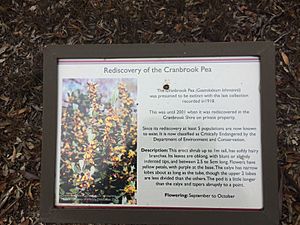Cranbrook pea facts for kids
Quick facts for kids Gastrolobium lehmannii |
|
|---|---|
 |
|
| Conservation status | |
| Scientific classification | |
| Kingdom: | |
| (unranked): | |
| (unranked): | |
| (unranked): | |
| Order: | |
| Family: | |
| Genus: | |
| Species: |
G. lehmannii
|
| Binomial name | |
| Gastrolobium lehmannii Meisn.
|
|
| Synonyms | |
|
|
The Gastrolobium lehmannii, also called the Cranbrook Pea, is a special type of shrub. It belongs to the Fabaceae family, which includes many pea and bean plants. This plant is only found in a specific area of Western Australia. Because it is rare, it is listed as a vulnerable species.
Contents
What the Cranbrook Pea Looks Like
The Cranbrook Pea is a shrub that grows upright and has a rounded, dome-like shape. It can reach up to 1.5 metres (about 5 feet) tall. Its branches are soft and covered with fine hairs. The leaves are oblong, meaning they are longer than they are wide.
This plant blooms, or flowers, between September and October. Its flowers are very colorful, showing shades of orange, yellow, and red.
Some plants in the Gastrolobium group can be poisonous. Scientists are still studying if the Cranbrook Pea also has these toxic properties.
Where the Cranbrook Pea Lives
The Cranbrook Pea is an endemic plant. This means it naturally grows only in one specific place in the world. For the Cranbrook Pea, that place is Western Australia.
The first time this plant was collected by a botanist was in 1841 by James Drummond (botanist). Later, in 1919, Charles Gardner found it again. He found it between the towns of Cranbrook and the Stirling Ranges, and also near the Blackwood River area.
For a while, people thought the Cranbrook Pea had disappeared completely. But thankfully, it was found again between 2000 and 2002! Now, there are special programs in place to help protect and save the remaining plants.
Protecting the Cranbrook Pea
The Cranbrook Pea is considered a "vulnerable" species. This means it is at risk of becoming endangered if we don't protect it.
In Western Australia, the plant was first listed as "rare" under the Wildlife Conservation Act 1950. Then, in 2006, it was officially listed as "vulnerable" under a different law called the Environment Protection and Biodiversity Conservation Act 1999. These laws help make sure that special plants like the Cranbrook Pea are protected.
How Scientists Classify the Cranbrook Pea
Scientists use a system called taxonomy to name and group living things. The Cranbrook Pea's scientific name is Gastrolobium lehmannii.
The plant was first officially described in 1844 by a botanist named Carl Meissner. Later, in 1995, another botanist, Michael Crisp, thought it belonged to a different group called Nemcia. However, in 2002, a group of scientists led by Chandler decided that it should be moved back to the Gastrolobium group. This shows how scientists sometimes change their minds as they learn more about plants!


